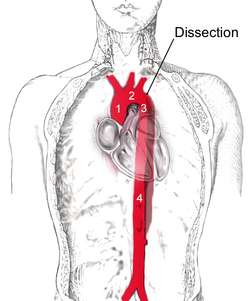Aortic dissection

Editor-In-Chief: Prab R Tumpati, MD
Obesity, Sleep & Internal medicine
Founder, WikiMD Wellnesspedia &
W8MD medical weight loss NYC and sleep center NYC
| Aortic dissection | |
|---|---|

| |
| Synonyms | Dissecting aneurysm |
| Pronounce | N/A |
| Specialty | N/A |
| Symptoms | Severe chest pain, back pain, shortness of breath, syncope |
| Complications | Aortic rupture, organ failure, stroke, cardiac tamponade |
| Onset | Sudden |
| Duration | Can be acute or chronic |
| Types | Stanford type A, Stanford type B |
| Causes | Hypertension, connective tissue disorders, trauma, bicuspid aortic valve |
| Risks | Hypertension, atherosclerosis, genetic disorders (e.g., Marfan syndrome, Ehlers-Danlos syndrome) |
| Diagnosis | CT scan, MRI, transesophageal echocardiogram |
| Differential diagnosis | Myocardial infarction, pulmonary embolism, pericarditis |
| Prevention | Blood pressure control, smoking cessation |
| Treatment | Surgery, medication (e.g., beta blockers, vasodilators) |
| Medication | N/A |
| Prognosis | Variable, depends on type and treatment |
| Frequency | 3 per 100,000 per year |
| Deaths | High mortality if untreated |
An aortic dissection represents a serious and often critical condition in which there is a progressive tear in the innermost layer (tunica intima) of the aorta, the largest artery in the body. This tear allows blood to flow between the layers of the aortic wall, forcing the layers apart.

Pathophysiology[edit]
In an aortic dissection, blood penetrates the intima and enters the tunica media, the middle layer of the aortic wall. This leads to the formation of a ""false lumen," a new, abnormal channel within the aortic wall. The process can progressively extend along the length of the aorta, potentially interfering with the branches of the aorta and leading to a range of complications.

Risk Factors[edit]
Key risk factors for aortic dissection include uncontrolled high blood pressure (hypertension), conditions that cause inflammation of the arteries (like vasculitis), certain genetic disorders such as Marfan syndrome, and a history of heart surgery or procedures. Aging, smoking, high cholesterol levels, and a family history of the condition also contribute to the risk.
Clinical Presentation[edit]
Symptoms of an aortic dissection can mimic those of other conditions, making it challenging to diagnose. The most common symptom is severe, sudden chest pain often described as tearing or ripping, radiating to the back. Other symptoms may include shortness of breath, loss of consciousness, weak or absent pulse in one arm, or leg pain or paralysis.
Diagnosis[edit]
Diagnosis is often made based on clinical signs and symptoms, and is confirmed by imaging studies, such as computed tomography (CT) angiography, magnetic resonance imaging (MRI), or transesophageal echocardiography.
Treatment[edit]
The treatment for aortic dissection depends on the location and extent of the dissection. Type A dissections, which involve the ascending aorta, are typically treated with emergency surgery due to their high risk of complications. Type B dissections, which occur distal to the subclavian artery, can often be managed medically with blood pressure control, although surgery may be needed in certain situations.
Prevention[edit]
Preventive measures for aortic dissection largely involve managing risk factors. This includes controlling hypertension, treating conditions like vasculitis, and monitoring those with genetic conditions like Marfan syndrome. Additionally, individuals with a history of aortic dissection may require regular follow-up imaging to monitor the aorta.
Ad. Transform your life with W8MD's Budget GLP-1 injections from $75


W8MD offers a medical weight loss program to lose weight in Philadelphia. Our physician-supervised medical weight loss provides:
- Weight loss injections in NYC (generic and brand names):
- Zepbound / Mounjaro, Wegovy / Ozempic, Saxenda
- Most insurances accepted or discounted self-pay rates. We will obtain insurance prior authorizations if needed.
- Generic GLP1 weight loss injections from $75 for the starting dose.
- Also offer prescription weight loss medications including Phentermine, Qsymia, Diethylpropion, Contrave etc.
NYC weight loss doctor appointmentsNYC weight loss doctor appointments
Start your NYC weight loss journey today at our NYC medical weight loss and Philadelphia medical weight loss clinics.
- Call 718-946-5500 to lose weight in NYC or for medical weight loss in Philadelphia 215-676-2334.
- Tags:NYC medical weight loss, Philadelphia lose weight Zepbound NYC, Budget GLP1 weight loss injections, Wegovy Philadelphia, Wegovy NYC, Philadelphia medical weight loss, Brookly weight loss and Wegovy NYC
|
WikiMD's Wellness Encyclopedia |
| Let Food Be Thy Medicine Medicine Thy Food - Hippocrates |
Medical Disclaimer: WikiMD is not a substitute for professional medical advice. The information on WikiMD is provided as an information resource only, may be incorrect, outdated or misleading, and is not to be used or relied on for any diagnostic or treatment purposes. Please consult your health care provider before making any healthcare decisions or for guidance about a specific medical condition. WikiMD expressly disclaims responsibility, and shall have no liability, for any damages, loss, injury, or liability whatsoever suffered as a result of your reliance on the information contained in this site. By visiting this site you agree to the foregoing terms and conditions, which may from time to time be changed or supplemented by WikiMD. If you do not agree to the foregoing terms and conditions, you should not enter or use this site. See full disclaimer.
Credits:Most images are courtesy of Wikimedia commons, and templates, categories Wikipedia, licensed under CC BY SA or similar.
Translate this page: - East Asian
中文,
日本,
한국어,
South Asian
हिन्दी,
தமிழ்,
తెలుగు,
Urdu,
ಕನ್ನಡ,
Southeast Asian
Indonesian,
Vietnamese,
Thai,
မြန်မာဘာသာ,
বাংলা
European
español,
Deutsch,
français,
Greek,
português do Brasil,
polski,
română,
русский,
Nederlands,
norsk,
svenska,
suomi,
Italian
Middle Eastern & African
عربى,
Turkish,
Persian,
Hebrew,
Afrikaans,
isiZulu,
Kiswahili,
Other
Bulgarian,
Hungarian,
Czech,
Swedish,
മലയാളം,
मराठी,
ਪੰਜਾਬੀ,
ગુજરાતી,
Portuguese,
Ukrainian


